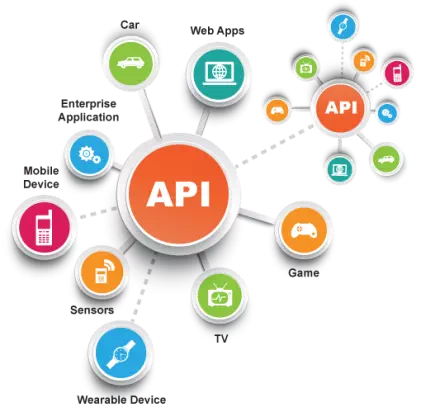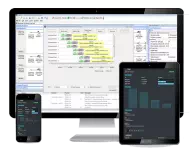API & MicroServices Development
Aceonics API & MicroServices Implementation delivers a hyper-connected digital ecosystem for your business. Our suite of offerings is helping enterprises extend market reach, streamline business processes and create new sources of value.
Some information about API & MicroServices
What is an API?
API is the acronym for Application Programming Interface, which is a software intermediary that allows two applications to talk to each other. Each time you use an app like Facebook, send an instant message, or check the weather on your phone, you’re using an API.
For example, when you use an application on your mobile phone, the application connects to the Internet and sends data to a server. The server then retrieves that data, interprets it, performs the necessary actions and sends it back to your phone. The application then interprets that data and presents you with the information you wanted in a readable way. This is what an API is - all of this happens via API.

Advantages of using APIs

Automation
With APIs, computers rather than people can manage the work. Through APIs, agencies can update work flows to make them quicker and more productive.

Application
Because APIs can access the app components, the delivery of services and information is more flexible.

More scope
With an API an application layer can be created which can be used to distribute information and services to new audiences which can be personalized to create custom user experiences.

New data available
An API allows all of the information generated at the government level to be available to every citizen, not just a select few.

Efficiency
When access is provided to an API, the content generated can be published automatically and is available for every channel. It allows it to be shared and distributed more easily.

Integration
APIs allow content to be embedded from any site or application more easily. This guarantees more fluid information delivery and an integrated user experience.

Personalization
Through APIs any user or company can customize the content and services that they use the most.

Adaptation
Needs change over time and APIs help to anticipate changes. When working with this technology, data migration is supported better, and the information is reviewed more closely. In short, APIs make service provision more flexible.

What is MicroServices?
Microservice architecture, or simply microservices, is a distinctive method of developing software systems that tries to focus on building single-function modules with well-defined interfaces and operations. The trend has grown popular in recent years as Enterprises look to become more Agile and move towards a DevOps and continuous testing. Microservices can help create scalable, testable software that can be delivered weekly, not yearly.
Microservices have many benefits for Agile and DevOps teams - as Martin Fowler points out, Netflix, eBay, Amazon, Twitter, PayPal, and other tech stars have all evolved from monolithic to microservices architecture. Unlike microservices, a monolith application is built as a single, autonomous unit. This make changes to the application slow as it affects the entire system. A modification made to a small section of code might require building and deploying an entirely new version of software. Scaling specific functions of an application, also means you have to scale the entire application.
Microservices solve these challenges of montholic systems by being as modular as possible. In the simplest form, they help build an application as a suite of small services, each running in its own process and are independently deployable. These services may be written in different languages and may use different data storage techniques. While this results in the development of systems that are scalable and flexible, it needs a dynamic makeover.
Characteristics of MicroServices

Multiple Components
Software built as microservices can, by definition, be broken down into multiple component services. Why? So that each of these services can be deployed, tweaked, and then redeployed independently without compromising the integrity of an application. As a result, you might only need to change one or more distinct services instead of having to redeploy entire applications. But this approach does have its downsides, including expensive remote calls (instead of in-process calls), coarser-grained remote APIs, and increased complexity when redistributing responsibilities between components.

Built For Business
The microservices style is usually organized around business capabilities and priorities. Unlike a traditional monolithic development approach—where different teams each have a specific focus on, say, UIs, databases, technology layers, or server-side logic—microservice architecture utilizes cross-functional teams. The responsibilities of each team are to make specific products based on one or more individual services communicating via message bus. In microservices, a team owns the product for its lifetime, as in Amazon’s oft-quoted maxim “You build it, you run it".

Simple Routing
Microservices act somewhat like the classical UNIX system: they receive requests, process them, and generate a response accordingly. This is opposite to how many other products such as ESBs (Enterprise Service Buses) work, where high-tech systems for message routing, choreography, and applying business rules are utilized. You could say that microservices have smart endpoints that process info and apply logic, and dumb pipes through which the info flows.

Decentralized
Since microservices involve a variety of technologies and platforms, old-school methods of centralized governance aren’t optimal. Decentralized governance is favored by the microservices community because its developers strive to produce useful tools that can then be used by others to solve the same problems. Just like decentralized governance, microservice architecture also favors decentralized data management. Monolithic systems use a single logical database across different applications. In a microservice application, each service usually manages its unique database.

Failure Resistant
Like a well-rounded child, microservices are designed to cope with failure. Since several unique and diverse services are communicating together, it’s quite possible that a service could fail, for one reason or another (e.g., when the supplier isn’t available). In these instances, the client should allow its neighboring services to function while it bows out in as graceful a manner as possible. However, monitoring microservices can help prevent the risk of a failure. For obvious reasons, this requirement adds more complexity to microservices as compared to monolithic systems architecture.

Evolutionary
Microservices architecture is an evolutionary design and, again, is ideal for evolutionary systems where you can’t fully anticipate the types of devices that may one day be accessing your application.. Many applications start based on monolithic architecture, but as several unforeseen requirements surfaced, can be slowly revamped to microservices that interact over an older monolithic architecture through APIs.
Service Offerings
Open API Business Strategy for Monetization of APIs
Pluggable IoT Integration using APIs
Fast Data & Analytics for Real Time Decisions on multiple device interfaces
Digital Experience Layer for Optimizing user experience and driving self-servicing
Monoliths to Microservices App Rewrite and Cloud Enablement
Hybrid Integration for multi-cloud ecosystem
Solution Offerings
Microservices Platform
A prefabricated microservices platform for API-led development powered by open source framework and tools
API Platform Operation Management
A set of templates, utilities and re-usable technical components for streamlining API platform operations
DevOps Platform
Toolsets to support end to end DevOps for distributed agile delivery
Integration Workbench
Aceonics tool to automate pattern based interface build, unit testing and deployment cycles while enabling continuous integration and delivery
Open API Framework
Open API reference architecture and set of APIs for Banking and Telco domains
Banking and Telco APIs
A set of pre-identified APIs to support an API first approach for digital transformation